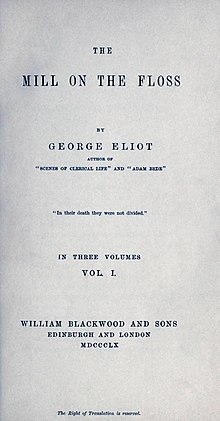 Title page of the first edition, 1860 | |
| Author | George Eliot |
|---|---|
| Language | English |
| Genre | Novel Psychological fiction Domestic fiction |
| Set in | Lincolnshire, c. 1829–1840 |
| Publisher | William Blackwood and Sons, Edinburgh and London |
Publication date | 4 April 1860 |
| Publication place | United Kingdom |
| Media type | Print (hardback & paperback): octavo |
| Pages | 993, in three volumes |
| 823.8 | |
| LC Class | PR4664 .A1 1979 |
| Preceded by | Adam Bede |
| Followed by | Silas Marner |
| Text | The Mill on the Floss at Wikisource |
The Mill on the Floss is a novel by English author George Eliot, first published in three volumes on 4 April 1860 by William Blackwood and Sons. The first American edition was published by Harper & Brothers, Publishers, New York.

Spanning a period of 10 to 15 years, the novel details the lives of Tom and Maggie Tulliver, siblings who grow up at Dorlcote Mill on the River Floss. The mill is at the confluence of the Floss and the smaller River Ripple, near the village of St Ogg's in Lincolnshire, England. Both the rivers and the village are fictional.[1]
- ^
Henry, Nancy (7 May 2012). The Life of George Eliot: A Critical Biography. Wiley Blackwell Critical Biographies. John Wiley & Sons (published 2012). p. 26. ISBN 9781405137058. Retrieved 28 January 2016.
The image of coal-laden ships floating into port that opens The Mill on the Floss seems to be informed by a memory of coal barges on the canal from Mary Ann's childhood and transferred to her fictional River Floss[...].